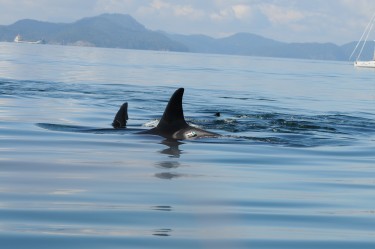
The speed of vessels operating near endangered killer whales in Washington is the most influential factor – more so than vessel size – in how much noise from the boats reaches the whales, according to a new study published today in the online journal PLOS ONE.
Previous studies have shown that Southern Resident killer whales alter their behavior in the presence of vessels and associated noise, which affects their ability to communicate and find food. Research has also found that the whales likely expend extra energy to call more loudly when boats are operating nearby.
The new study by scientists from the University of Washington and National Oceanic and Atmospheric Administration (NOAA) Fisheries is the first to examine how much noise from individual boats reaches the whales in the inland waters of Washington and British Columbia, where they are a popular attraction for recreational and commercial whale watching vessels.
“It definitely seems that speed is the most important predictor of the noise levels whales experience,” said Juliana Houghton, a recent graduate of the UW’s School of Aquatic and Fishery Sciences and lead author of the study.
Read more at UW Today »
